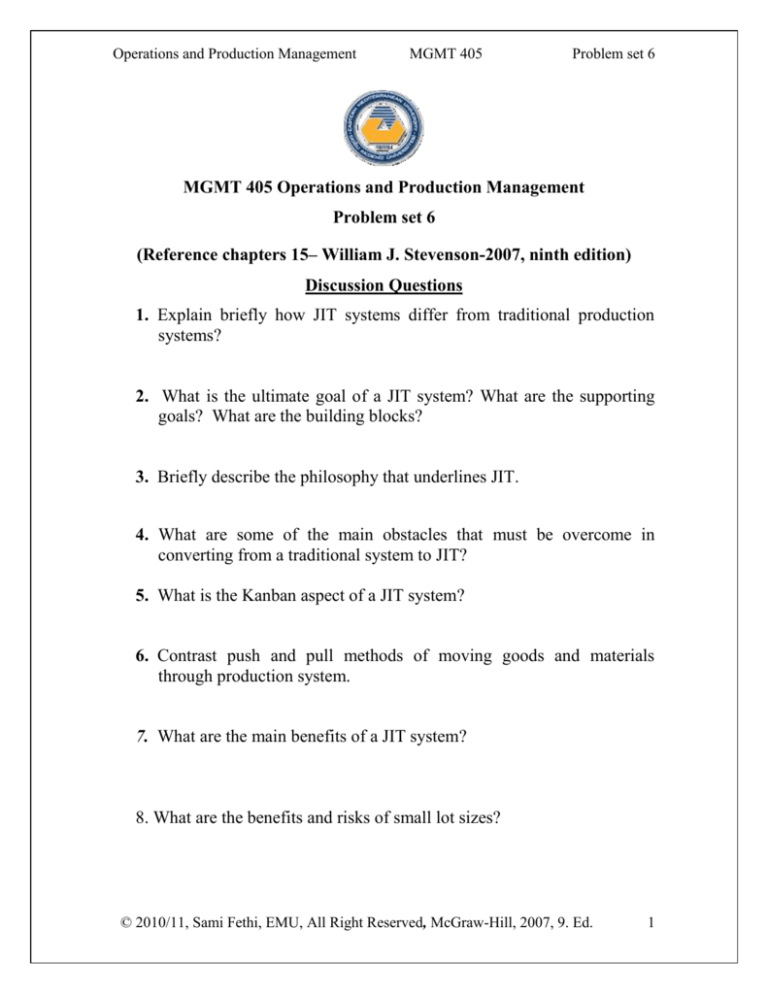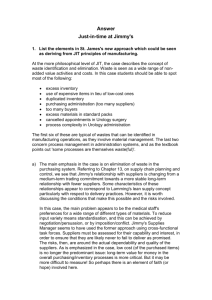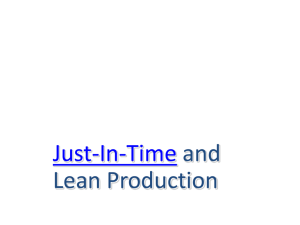
Operations and Production Management
MGMT 405
Problem set 6
MGMT 405 Operations and Production Management
Problem set 6
(Reference chapters 15– William J. Stevenson-2007, ninth edition)
Discussion Questions
1. Explain briefly how JIT systems differ from traditional production
systems?
2. What is the ultimate goal of a JIT system? What are the supporting
goals? What are the building blocks?
3. Briefly describe the philosophy that underlines JIT.
4. What are some of the main obstacles that must be overcome in
converting from a traditional system to JIT?
5. What is the Kanban aspect of a JIT system?
6. Contrast push and pull methods of moving goods and materials
through production system.
7. What are the main benefits of a JIT system?
8. What are the benefits and risks of small lot sizes?
© 2010/11, Sami Fethi, EMU, All Right Reserved, McGraw-Hill, 2007, 9. Ed.
1
Operations and Production Management
MGMT 405
Problem set 6
Problems
1. A manager wants to determine the number of containers to use for incoming parts
for a Kanban system to be installed next month. The process will have a usage rate of
80 pieces per hour. Because the process is new, the manager has assigned an
inefficiency factor of 0.35. Each container holds 45 pieces and it takes an average of
75 minutes to complete a cycle .
(a) How many containers should be used?
(b) Will more or fewer containers be required as the system improves? Why?
2. A JIT system uses Kanban cards to authorize movement of incoming parts. In one
portion of the system , a work center uses an average of 100 parts per hour while
running. The manager has assigned an inefficiency factor of 0.20 to the center.
Standart container are designed to hold six dozen parts each. The cycle time for parts
containers is about 105 minutes.
(a) How many containers are needed?
(b) What is the maximum inventory of parts in the system?
(c) If we assume that 0.75 containers are empty and 0.75 full at any given time, what
is the average inventory in the system for original problem? Explain briefly the figure
computed.
3. A company is trying to reduce inventory and wants experts to install a Kanban
system for compressors on one of its assembly lines. The records are given as
follows: set-up cost =10 MU, Annual holing cost per compressor is 100 MU,
lead-time is 3 days, daily production is 200 compressors, annual usage is 50
weeks based on 5 working days and safety stock is half day’s production of
compressors.
© 2010/11, Sami Fethi, EMU, All Right Reserved, McGraw-Hill, 2007, 9. Ed.
2
Operations and Production Management
MGMT 405
Problem set 6
(a) Compute the annual usage.
(b) Determine the size of the Kanban.
(c) Determine the number of Kanbans needed.
4. A manufacturer produces rocker-arm assemblies for use in the steering and
suspension system of four wheel drive trucks. A typical container of parts spends
0.02 day in processing and 0.08 day in materials handling and waiting during its
manufacturing cycle. The daily demand for part is 2000 units. Management
believes that demand for the rocker-arm assembly is uncertain enough to warrant
a safety stock equivalent of 10% of its authorised inventory.
(a) How many containers should be authorised, if there are 22 parts in each container?
(b) How many containers would be needed, if there is a proposal to revise the plant
layout which would cut materials handling and waiting time per container to 0.06
day?
5. Suppose a department produces four models as can be seen in the following table.
Using the production sequence as F-G-H-K.
(a) Determine the number of cycle per day for this set of products that achieves
fairly level production?
(b) Determine the production quantity per cycle for this set of products that
achieves fairly level production?
© 2010/11, Sami Fethi, EMU, All Right Reserved, McGraw-Hill, 2007, 9. Ed.
3












